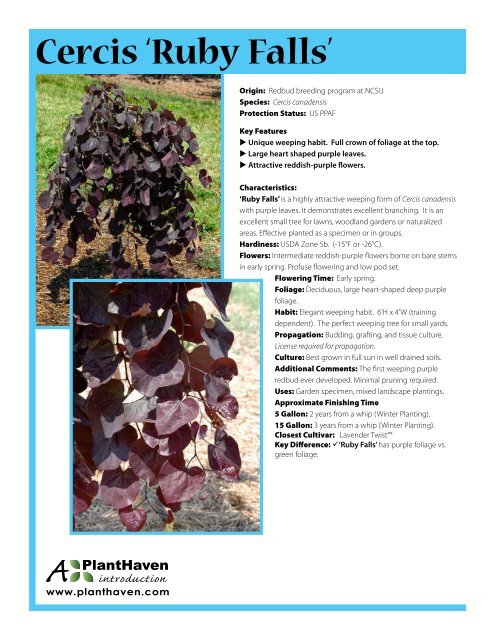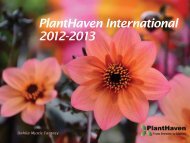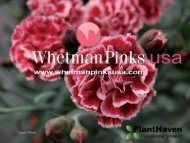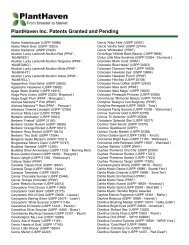Cercis 'Ruby Falls' - PlantHaven
Cercis 'Ruby Falls' - PlantHaven
Cercis 'Ruby Falls' - PlantHaven
Create successful ePaper yourself
Turn your PDF publications into a flip-book with our unique Google optimized e-Paper software.
<strong>Cercis</strong> ‘Ruby Falls’<br />
www.planthaven.com<br />
Origin: Redbud breeding program at NCSU<br />
Species: <strong>Cercis</strong> canadensis<br />
Protection Status: US PPAF<br />
Key Features<br />
Unique weeping habit. Full crown of foliage at the top.<br />
Large heart shaped purple leaves.<br />
Attractive reddish-purple flowers.<br />
Characteristics:<br />
‘Ruby Falls’ is a highly attractive weeping form of <strong>Cercis</strong> canadensis<br />
with purple leaves. It demonstrates excellent branching. It is an<br />
excellent small tree for lawns, woodland gardens or naturalized<br />
areas. Effective planted as a specimen or in groups.<br />
Hardiness: USDA Zone 5b. (-15°F or -26°C).<br />
Flowers: Intermediate reddish-purple flowers borne on bare stems<br />
in early spring. Profuse flowering and low pod set.<br />
Flowering Time: Early spring.<br />
Foliage: Deciduous, large heart-shaped deep purple<br />
foliage.<br />
Habit: Elegant weeping habit. 6’H x 4’W (training<br />
dependent). The perfect weeping tree for small yards.<br />
Propagation: Budding, grafting, and tissue culture.<br />
License required for propagation.<br />
Culture: Best grown in full sun in well drained soils.<br />
Additional Comments: The first weeping purple<br />
redbud ever developed. Minimal pruning required.<br />
Uses: Garden specimen, mixed landscape plantings.<br />
Approximate Finishing Time<br />
5 Gallon: 2 years from a whip (Winter Planting).<br />
15 Gallon: 3 years from a whip (Winter Planting).<br />
Closest Cultivar: Lavender Twist<br />
Key Difference: ‘Ruby Falls’ has purple foliage vs.<br />
green foliage.
<strong>Cercis</strong> ‘Merlot’<br />
www.planthaven.com<br />
Origin: Redbud breeding program at NCSU<br />
Species: <strong>Cercis</strong> canadensis (Texensis group).<br />
Protection Status: US PPAF<br />
Key Features<br />
Excellent heat & drought tolerance. (The C. texensis<br />
factor).<br />
Outstanding glossy dark purple foliage.<br />
Tight dense habit making this the perfect tree for<br />
small yards.<br />
Characteristics:<br />
‘Merlot’ is partially derived from the texensis form of redbud<br />
which confers heat and drought tolerance. ‘Merlot’ has<br />
glossy, small rounded dark purple leaves and has an upright<br />
vase shaped growth habit. Mature plants produce abundant<br />
bright pink flowers. Pod set is minimal. ‘Merlot’ shows little<br />
leaf stress and necrosis in the heat of summer.<br />
Hardiness: USDA Zone 6. (-10°F or -23°C).<br />
Flowers: Reddish-purple flowers borne on bare stems in<br />
early spring. Profuse flowering and low pod set.<br />
Flowering Time: Early spring.<br />
Foliage: Deciduous, large rounded glossy dark purple<br />
foliage.<br />
Habit: Semi-upright vase shaped habit. 12’ x 15’. The perfect<br />
tree for small yards.<br />
Propagation: Budding, grafting, and tissue culture. License<br />
required for propagation.<br />
Culture: Best grown in full sun in well drained soil.<br />
Additional Comments: Relatively drought tolerant.<br />
Minimal training and pruning required.<br />
Uses: Garden specimen, landscape plantings, street tree.<br />
Approximate Finishing Time<br />
5 Gallon: 2 years from a whip (Winter Planting).<br />
15 Gallon: 3 years from a whip (Winter Planting).<br />
Key Differences: Compared to C. ‘Forest Pansy’ ‘Merlot’:<br />
is more heat and drought tolerant.<br />
has a tighter and more dense habit.<br />
shows upright, vase-shaped growth habit.<br />
has glossier foliage.
<strong>Cercis</strong> ‘Hearts of Gold’<br />
www.planthaven.com<br />
Origin: Jon Roethling<br />
Species: <strong>Cercis</strong> canadensis<br />
Protection Status: US PP #17,740<br />
Characteristics:<br />
This exciting selection of eastern redbud has<br />
burst onto the scene just within the last three<br />
years and has become an overnight sensation<br />
in plant circles. This is the first known, goldfoliaged<br />
<strong>Cercis</strong> for the U.S. Market. New<br />
leaves emerge red then turn to gold. Where<br />
leaves are shaded by others they will turn to<br />
green. ‘Hearts of Gold’ offers a perfect way to<br />
brighten the grayest day and provides a riot<br />
of color in early spring as they flower even<br />
before foliage emerges. Its tiny lavenderpurple<br />
redbud blooms are early harbingers<br />
of spring in the landscape. In summer, the<br />
gold foliage is burn-resistant even in full sun.<br />
A U.S. native, this gold redbud is as vigorous<br />
as green varieties and will grow to 10’ in the<br />
first 5 years. At maturity it will reach 15’ tall by<br />
18’ wide, making it perfect for hedges or as<br />
a specimen planting. One’s imagination can<br />
run wild with the landscape possibilities of<br />
this great new plant. A spectacular plant for<br />
illuminating a shady spot in the garden!<br />
Hardiness: Zone 4 to 10, to be tested.<br />
Definitely 5 to 9.<br />
Bloom: Clusters of sweet pea blooms, bright<br />
lavender purple, early spring.<br />
Foliage: Intense golden color, heart-shaped.<br />
New growth is red, shaded leaves turn green.<br />
Habit: Vase-shaped, pendulous.<br />
Propagation: Semi-ripe cuttings. License<br />
required for propagation.<br />
Culture: Well-drained soils in full sun or<br />
partial shade. Drought tolerant.<br />
Duke Biscotti<br />
Biscotti & Associates<br />
4105 Edgewater Drive<br />
Ashtabula Oh 44004<br />
440.964.2887<br />
FAX: 440.964.2712
<strong>Cercis</strong> ‘Ace of Hearts’<br />
www.planthaven.com<br />
Origin: Paul B. E. Woody<br />
Species: <strong>Cercis</strong> canadensis<br />
Protection Status: US Plant Patent #17,161<br />
Characteristics:<br />
A dwarf Eastern Redbud! This brand new<br />
introduction has very small leaves and will<br />
probably mature at about 15 feet. A true<br />
genetic dwarf. The original plant is only 12’ tall<br />
by 15’ wide in 8+ years. The leaves, small but<br />
perfectly heart-shaped, are stacked on stems<br />
reminiscent of shingles on a roof and are held<br />
up the stems with elegant poise. In flower,<br />
however, this plant really performs. Its pale<br />
blooms, soft mauve with darker markings, are<br />
produced in large quantities, studding the dark<br />
stems in late spring. This variety is attractive<br />
to bees, butterflies and/or birds. It is droughttolerant;<br />
suitable for xeriscaping. ‘Ace of Hearts’<br />
is perfect for the smaller sized yard. One of the<br />
most distinctive redbuds in leaf!<br />
Hardiness: USDA Zones 5-9<br />
Bloom: Clusters of light violet sweet pea-like<br />
blooms borne in early spring.<br />
Foliage: Small, semi-glossy heart-shaped<br />
leaves.<br />
Habit: Compact tree with a dense domeshaped<br />
canopy (12’ x 15’ in 8 years).<br />
Propagation: Tissue culture, budding/<br />
grafting. License required for propagation.<br />
Culture: Well-drained soils in full sun to partial<br />
shade. Drought tolerant.<br />
Duke Biscotti<br />
Biscotti & Associates<br />
4105 Edgewater Drive<br />
Ashtabula Oh 44004<br />
440.964.2887<br />
FAX: 440.964.2712
<strong>Cercis</strong> ‘Little Woody’<br />
www.planthaven.com<br />
Origin: Paul B. E. Woody<br />
Species: <strong>Cercis</strong> canadensis<br />
Protection Status: US Plant Patent #15,854<br />
Characteristics:<br />
One of the first two compact eastern redbuds<br />
ever introduced, ‘Little Woody’ is a most<br />
distinctive variety. The original plant is only<br />
10’ tall by 8’ wide in 8+ years. Its small, dark<br />
green, puckered leaves are attractively tinged<br />
with red when they emerge. They are neatly<br />
arranged up the stems, each directly above<br />
the next. Seed set is practically non-existent.<br />
Hardiness: USDA Zones 5-9<br />
Bloom: Clusters of light violet sweet pea-like<br />
blooms borne in early spring.<br />
Foliage: Dark, gnarled, and almost rubbery,<br />
rugose green leaves.<br />
Habit: Compact, vase-shaped (10’ x 8’ in 8<br />
years).<br />
Propagation: Tissue culture, budding/<br />
grafting. License required for propagation.<br />
Culture: Well-drained soils in full sun to<br />
partial shade. Drought tolerant.<br />
Duke Biscotti<br />
Biscotti & Associates<br />
4105 Edgewater Drive<br />
Ashtabula Oh 44004<br />
440.964.2887<br />
FAX: 440.964.2712







